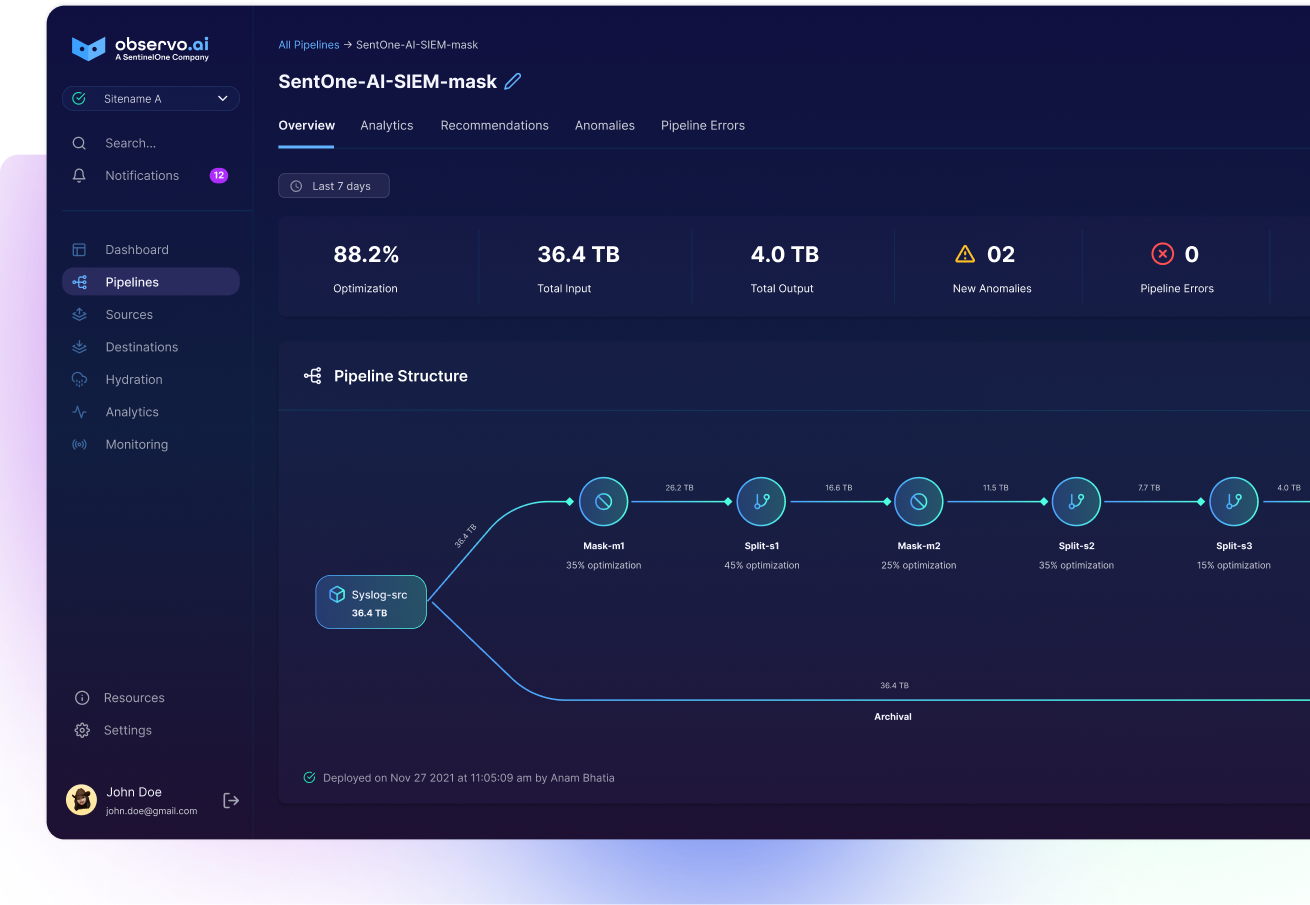Build vs. Buy: The True Cost of AI Security Data Pipelines

The Modern Security Data Dilemma
Security operations today are drowning in data. With cloud workloads, SaaS tools, endpoint agents, and firewall appliances all generating telemetry 24/7, many organizations are reaching a tipping point—unable to afford full visibility, yet afraid of what might slip through the cracks.
That’s why AI-native security data pipelines have emerged as a critical solution. These intelligent systems filter out noise, enrich logs in motion, align schema formats, and route the right data to the right tools—delivering faster insights at lower cost. But once the need is clear, security teams face a familiar question: should we build this in-house or buy a purpose-built solution?
This blog explores the true cost of building vs. buying AI security data pipelines—and why, for most enterprises, the build path is riskier, more expensive, and slower to deliver value.
Why Security Data Pipelines Matter More Than Ever
Security telemetry isn’t just growing—it’s exploding. Organizations today are ingesting massive volumes of data from firewalls, VPC flow logs, DNS traffic, Active Directory events, endpoint detection tools, SaaS platforms, and more. As cloud adoption accelerates and hybrid architectures expand, every system, service, and application generates telemetry around the clock. The result is a firehose of data that’s often too fast, too fragmented, and too voluminous for traditional SIEM and observability platforms to handle effectively.
The consequences of this data overload are significant. Costs can skyrocket as organizations struggle to keep up with rising egress, compute, and storage demands. Many SIEM platforms charge by ingestion volume, making it prohibitively expensive to analyze every log in real time. And even when budget allows for scale, performance suffers—queries slow down, storage tiers balloon, and retention strategies start cutting corners.
But cost is just the beginning. Without upstream optimization, SOC teams are buried under alert fatigue caused by redundant or low-value events. When every minor change in state or expected behavior is logged as an event, security analysts waste time chasing noise instead of identifying real threats. Worse, critical signals may get lost entirely—either because they’re hidden in the clutter or because data pipelines drop or sample logs to avoid exceeding capacity. This creates blind spots that can result in missed detections and compliance violations.
Optimization isn’t just about reducing volume—it’s about making data more actionable. By enriching telemetry with metadata like threat intelligence, geo-IP, identity attributes, and even sentiment analysis, organizations can distinguish high-risk events from routine activity. Pattern recognition and clustering techniques can group redundant logs, highlight anomalies, and surface meaningful outliers. These enhancements allow teams to prioritize more effectively, reduce mean time to detect and respond, and regain confidence in their data. Without this kind of intelligence built into the pipeline, security data remains raw, reactive, and expensive.
AI security data pipelines solve these problems by optimizing telemetry upstream—before it hits your SIEM. But building that pipeline is no small task.
What It Takes to Build a Modern Security Data Pipeline
On the surface, building a pipeline might sound manageable. Use open-source tools like Fluentd, Logstash, or Kafka; write some Grok patterns; configure a few enrichment rules. But once you need enterprise-grade performance, things get complex fast.
Here’s what’s actually required to build and maintain an AI-powered data pipeline:
- Source ingestion across dozens of tool types and data formats
- Dynamic parsing and schema normalization—especially for unstructured or custom logs
- AI-based filtering and summarization to reduce volume by up to 80%
- Real-time enrichment with threat intel, GeoIP, sentiment scoring, and identity data
- PII masking and compliance controls across diverse global data sources
- Schema alignment with standards like ECS, Splunk CIM, or Sentinel
- Smart routing and tiering to direct data to SIEMs, data lakes, and cold storage
- Agent and edge collector support for hybrid environments
Now multiply that by the need for 24/7 availability, fast incident triage, continuous tuning, and auditability. Suddenly, it’s not a pipeline. It’s a full-blown software product.
The True Cost of Building In-House
Building in-house gives you full control—but also full responsibility. Consider the following cost centers:
Engineering Resources
Building an AI-powered data pipeline from scratch requires more than a few generalist developers. You’ll need a cross-functional team including full-stack engineers, pipeline architects, data scientists, and cloud infrastructure experts. These specialists must design, secure, scale, and support the pipeline across your entire telemetry environment. And because your environment is constantly evolving—with new sources, formats, and requirements—this isn’t a one-time investment. It’s an ongoing commitment to engineering bandwidth that could otherwise be focused on core business priorities.
Time to Value
Even getting a basic version of a custom pipeline off the ground takes months. During that time, your SIEM and storage costs continue to climb, analysts are still manually triaging alerts, and low-value logs are still flooding your environment. Every week spent building in-house delays the operational and financial benefits of data reduction, enrichment, and intelligent routing. In security, time is not a luxury—and the longer it takes to optimize your pipeline, the greater the risk of missed threats, budget overruns, and frustrated stakeholders.
AI and ML Expertise
AI-native features like log summarization, pattern generation, anomaly detection, and sentiment scoring don’t build themselves. They require deep machine learning expertise, access to training datasets, and the infrastructure to test, tune, and retrain models over time. These capabilities are critical for making telemetry more actionable—but they’re not something most in-house teams can bolt on quickly or effectively. Without AI expertise, a custom pipeline often becomes a rules-based system that’s brittle, reactive, and limited in scope.
Hidden Infrastructure Costs
Beyond salaries and development time, building your own pipeline means taking on a host of hidden infrastructure costs. Hosting, compute, storage, monitoring, observability, load balancing, and security hardening all come into play—especially when processing telemetry at scale. You’ll need to design for horizontal scalability, high availability, and multi-cloud compatibility. And when something breaks at 2 a.m., there’s no vendor support to call. You own the uptime, performance, and troubleshooting from end to end.
Ongoing Maintenance
Security data is dynamic by nature. Every new log source, vendor integration, or product update introduces changes that your pipeline must accommodate. That means updating schemas, writing new parsers, testing enrichment logic, and ensuring compatibility with downstream tools. Over time, each manually written rule or Grok pattern becomes technical debt. And as your team shifts or scales, institutional knowledge can fade—turning yesterday’s quick fix into tomorrow’s critical incident. Maintenance isn’t just overhead—it’s a growing tax on your ability to stay agile and secure.
What You Get When You Buy an AI-Native Pipeline
AI-native pipelines are built to deliver everything above—without the overhead of managing it yourself.
Out-of-the-box integrations with firewalls, cloud platforms, endpoints, and SaaS
AI pipelines connect natively with the tools and platforms your security team already uses, from Palo Alto firewalls to Microsoft 365, AWS, and beyond. No custom connectors or long integration projects required—just plug in and start optimizing.
Automated Grok pattern generation for parsing even custom log types
These platforms automatically detect and parse unstructured logs, including those from proprietary or legacy applications. This eliminates the need to write and maintain fragile regex-based parsers.
80%+ volume reduction using AI summarization, filtering, and deduplication
They use machine learning to identify and suppress low-value, redundant, and repetitive logs before they hit your SIEM. This reduces infrastructure costs and accelerates detection without sacrificing visibility.
Real-time enrichment including GeoIP, threat intel, sentiment scoring, and identity mapping
They enrich every log in motion, adding critical context to make alerts more meaningful and investigations faster. This includes tagging with geolocation, known threat indicators, user and device identity, and even intent scoring based on language patterns.
Data lake creation and rehydration for long-term storage and compliance
They route compliance-required logs to low-cost object storage while maintaining full fidelity and searchability. When needed, data can be rehydrated back into your SIEM or analytics tools for investigation—without permanent indexing costs.
Support for ECS, Splunk CIM, and custom schema translation
An AI data pipeline aligns incoming data to Elastic Common Schema, Splunk CIM, or your organization’s own structure. That means better compatibility, faster searches, and easier dashboarding in your downstream tools.
The Strategic Tradeoff: Focus vs. Distraction
Building a pipeline might give you flexibility—but it turns your security team into a software company. Do you really want your most skilled engineers maintaining parsers, debugging edge collectors, or fighting schema drift?
Security teams should focus on detecting threats, improving coverage, and reducing risk—not babysitting brittle infrastructure.
A 10-Point Build-vs-Buy Checklist for Security Leaders
- Does this support our core mission?
- Do we have in-house expertise for AI and enrichment?
- How long will it take to build a usable version?
- Can we guarantee uptime, scale, and support?
- Are we confident in our ability to maintain compliance?
- What happens when sources or schemas change?
- Can we respond quickly to detection and routing needs?
- Are we ready to own every parser and regex forever?
- Will this help or hinder MTTR, MTTD, and alert fatigue?
- Is there a proven product that already solves this better?
Build or Buy?
The real question isn’t whether you can build your own AI security data pipeline. It’s whether you should.
With Observo AI, you get proven results:
- 80%+ data volume reduction
- 40% faster mean time to resolution (MTTR)
- 50%+ lower SIEM TCO
- Faster, cleaner insights across every log stream
For more information on the promise of an AI-native data pipeline, read The CISO Field Guide to AI Security Data Pipelines.




